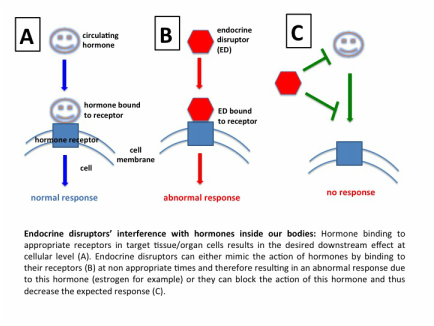Endocrine disruptors are chemicals that enter our body and can act as (mimic) a hormone, or interfere with/block its action, resulting in a change from what our own hormones would do (see figure below) which could affect our bodies and emotions. There is an ever growing number of examples of these disruptors now known to affect us, and possibly many more that we have not yet characterized. Some are natural, but many are man-made and used by us in ways that deliver them into our bodies. Exposure occurs by ingestion of food and water, inhalation of gases and particles, and through skin contact. These compounds are widespread and include drugs, pesticides such as DDT, chemicals used in the plastics industry, flame retardants, household cleaning products, cosmetic products (soaps, shampoos, creams, nail polish, etc), industrial by-products and pollutants, and fuels. Perfluorinated compounds (PFCs) found in water resistant clothes and non-stick frying pans (teflon-covered) are also believed to be endocrine disruptors,
The synthetic estrogen diethylstilbestrol (DES) was prescribed to pregnant women over 50 years ago to prevent miscarriages, and although it was not effective in doing so, in the early 1970s doctors reported vaginal cancers, reproductive defects (uterus and ovaries) and immune system suppression in young women that were later linked to their mothers having used DES.

So what to do? As with other issues like global warming for example, while we wait for tighter regulation, research and monitoring at country/region level, all we can do is be aware and informed (and educate others!) and try to avoid exposure as much as possible - especially in pregnancy and children. Avoid plastics, non-stick cookware and pesticides, eat organic, and spread the word.


 RSS Feed
RSS Feed